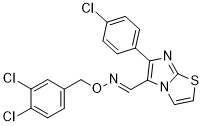| Cas No.: | 338404-52-7 |
| Chemical Name: | (E)-6-(4-chlorophenyl)imidazo[2,1-b]thiazole-5-carbaldehyde O-(3,4-dichlorobenzyl) oxime |
| Synonyms: | CITCO |
| SMILES: | ClC1=CC=C(C=C1Cl)CO/N=C/C2=C(C3=CC=C(Cl)C=C3)N=C4SC=CN42 |
| Formula: | C19H12Cl3N3Os |
| M.Wt: | 436.735 |
| Purity: | >98% |
| Sotrage: | Dry, dark and at 0 - 4 C for short term (days to weeks) or -20 C for long term (months to years). |
| Description: | CITCO, an imidazothiazole derivative, is a selective Constitutive androstane receptor (CAR) agonist. CITCO inhibits growth and expansion of brain tumour stem cells (BTSCs) and has an EC50 of 49 nM over pregnane X receptor (PXR), and no activity on other nuclear receptors[1]. |
| Target: | CAR, PXR[1] |
| In Vivo: | CITCO (intraperitoneal; on days 22, 24, 26, 30 and 36) with 25 μg results a significant decrease in tumour growth, which further decreases to an undetectable level after treatment with 100 μg CITCO [1]. Animal Model: Six- to eight-week-old male athymic nude mice[1] Dosage: 25 or 100 μg Administration: Intraperitoneal; on days 22, 24, 26, 30 and 36 Result: Decreased tumour growth. |
| In Vitro: | CITCO (1-50 μM; 48 hours) results in a dose-dependent inhibition of viable cell count and proliferation in both T98G and U87MG glioma and BTSCs[1]. CITCO (2.5, 5 μM; 48 hours) induces cell cycle arrest differentially in different BTSCs in culture, but not in normal astrocytes[1]. CITCO (2.5-10 μM; 48 hours) induces apoptosis in BTSCs in culture in dose dependently, but not in normal astrocytes[1]. CITCO (0-25 μM; 48 hours) causes the T98G and U87MG glioma and BTSCs expressing very low levels of CAR protein that increased significantly[1]. Cell Proliferation Assay[1] Cell Line: T98G, U87MG, DB29 and DB33 human glioma cells, astrocytes Concentration: 1, 2.5, 5, 10, 25, 50 μM Incubation Time: 48 hours Result: Resulted in a dose-dependent inhibition of viable cell count and proliferation. Cell Cycle Analysis[1] Cell Line: The T98G, U87MG, DB29 and DB33 glioma cells Concentration: 2.5, 5 μM Incubation Time: 48 hours Result: Induced cell cycle arrest differentially in different BTSCs in culture. Apoptosis Analysis[1] Cell Line: The T98G, U87MG, DB29 and DB33 glioma cells Concentration: 2.5, 5 or 10 μM Incubation Time: 48 hours Result: Increased the levels of Annexin V-positive apoptotic cells in dose dependently. Western Blot Analysis[1] Cell Line: T98G, U87MG, DB29 and DB33 glioma cells Concentration: 0 to 25 μM Incubation Time: 48 hours Result: The T98G, U87MG glioma and BTSCs expressed very low levels of CAR protein that increased significantly. |
| References: | [1]. Chakraborty S, et al. Constitutive androstane receptor agonist CITCO inhibits growth and expansion of brain tumour stem cells. Br J Cancer. 2011 Feb 1;104(3):448-59. |

 To enhance service speed and avoid tariff delays, we've opened a US warehouse. All US orders ship directly from our US facility.
To enhance service speed and avoid tariff delays, we've opened a US warehouse. All US orders ship directly from our US facility.




















